Lessons from the PSAC Strike and the Future of the Labour Movement in Canada
Late on April 30, Canada’s largest public-sector union and the federal government reached a tentative agreement ending one of the largest strikes in Canada’s history. For the previous 11 days, 120,000 public servants were on strike.
A few days later, the government also reached a tentative agreement with PSAC members working for the Canada Revenue Agency.
We were in the field with a national survey over the weekend an agreement was reached, interviewing 1,750 Canadian adults from April 28 to May 2. In that survey, we asked several questions about the strike. Specifically, I was interested in understanding:
- To what extent were Canadians paying attention to the strike?
- How disruptive was the strike for Canadians?
- Whether Canadians aware of the strike believed it was justified?
- And whether Canadians agree with some of the demands made by PSAC and its members.
The results indicate that Canadians were aware of the strike, but not paying particularly close attention. Few were directly impacted by the strike and Canadians were fairly split on whether it was justified or not.
But more important, perhaps for the future of the labour movement and future negotiations between governments and public sector workers, underlying opinions seem to favour organized labour – especially in an environment where the desire for more flexibility at work is widespread and a cost of living crisis is impacting how people think about wages.
Here’s what we found:
Only 1 in 3 Canadians were following news about the PSAC strike closely.
Older Canadians were following it more closely than younger Canadians. Union members generally were as likely to follow the strike as other Canadians. There was no political difference in attention to the story.
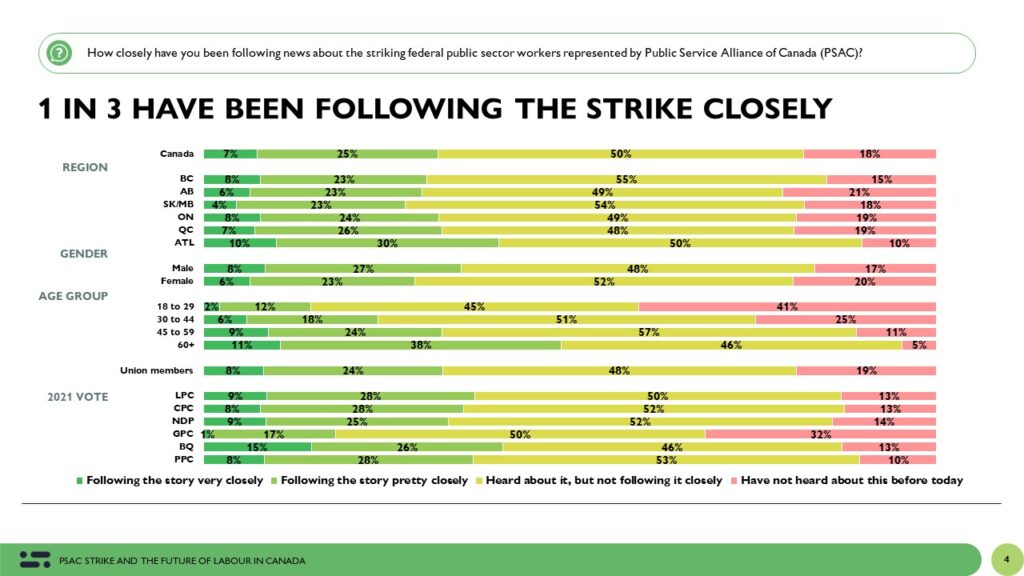
Only 4% of Canadians say the strike disrupted their lives “a lot”
The vast majority of Canadians report that the PSAC strike had either no impact or only a little impact on their lives. 10% said the strike disrupted their life somewhat while 4% say it impacted them a lot.
Younger Canadians were more likely to report the strike disrupting their lives. Union members were also somewhat more likely to say the strike disrupted their lives.

More feel the workers’ demands were justified
Among those aware of the PSAC strike, 45% believe the strike was completely or mostly justified while 37% feel it was unjustified. 18% were unsure.
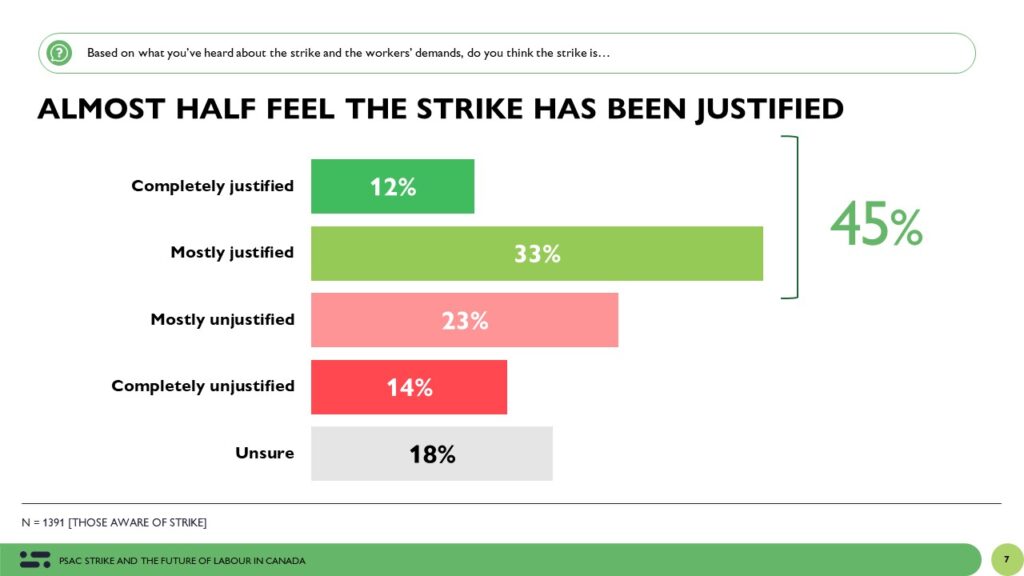
Those living in Quebec and Atlantic Canada were more likely to feel the strike was justified than those in other regions of the country. Younger Canadians were far more likely to feel the strike was justified than older ones. 63% of those 18 to 29 and 52% of those 30 to 44 feel the strike is justified while less than half of older Canadians share that view.
Politically, Liberal, NDP and BQ supporters tend to think the strike was justified while Conservative, Green, and PPC supporters are more divided.
It is noteworthy that a majority of the Liberal government’s own supporters think the strike was justified.

Beyond the PSAC Strike
But beyond the strike itself, the survey also asked Canadians their views on related topics.
For example, 60% of Canadians believe that gains made by large unions do benefit workers generally over time and this view is widely accepted by younger Canadians.
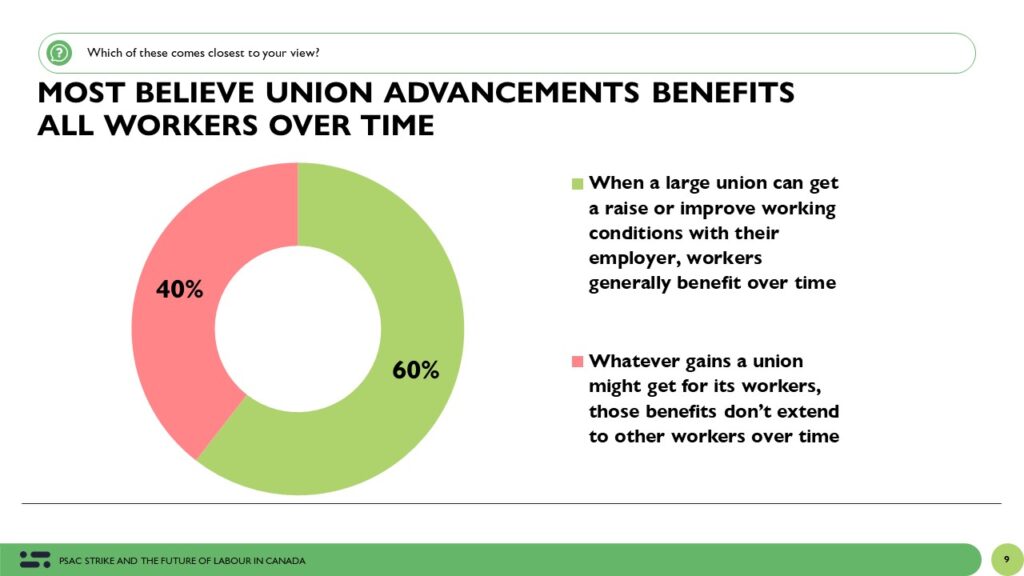
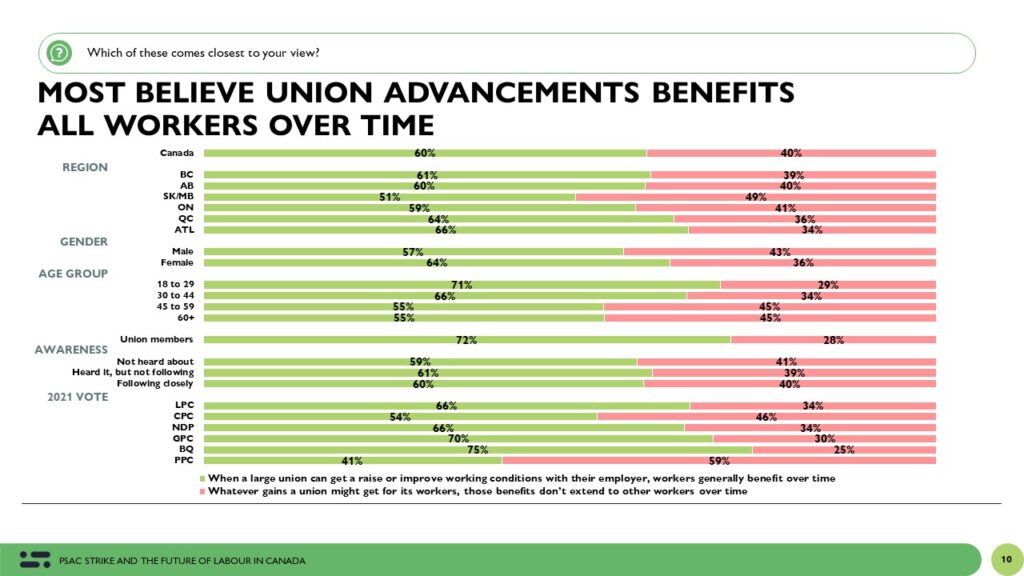
89% of Canadians agree that “wages should rise as the cost-of-living rises” including 91% of Liberal supporters, 86% of Conservative supporters, and 93% of NDP supporters.
There’s also a wide gender gap on this question. While 45% strongly agree that wages should rise as the cost of living rises, 59% of women feel this way.


Finally, 71% of working Canadians would like to work from home two days a week. 29% say they don’t want that ability.
Once again, younger Canadians are far more likely to want that flexibility than older working Canadians. Liberal, NDP, and GPC supporters are more likely to want to be able to work from home than Conservatives – although a majority of Conservative supporters would like that choice too.
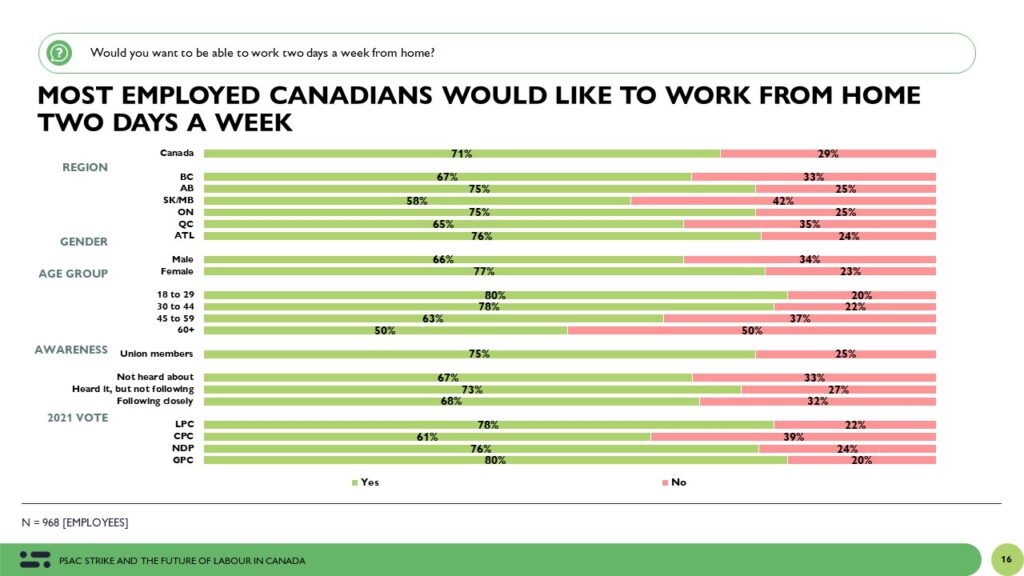
Would a unionized workplace mean better wages and working conditions? Non-unionized workers are split.
When non-unionized working Canadians are asked whether being unionized would lead to better wages and working conditions, 34% say yes, 32% say no and 34% are unsure.
Women are far more likely than men to see the benefit of unions (40% to 29%) while there isn’t much difference across age groups.
Interestingly, the same number of Liberal, Conservative, and NDP supporters who work in non-unionized workplaces think their wages and working conditions would be better if they were unionized – demonstrating there’s no real partisan divide.
What this all means?
First off, it’s clear that at the end of the strike, more Canadians sided with the workers on strike than with the government in that more felt the strike was justified. That makes sense since almost everyone agrees that wages should rise with the cost of living and most would like the flexibility to work from home a few days a week.
But what’s striking in these results is the generational divide we see throughout. Millennials and Zoomers (Gen Z) are far more likely to feel the strike was justified, that wages should rise with the cost of living, and that gains made by unions eventually improve working conditions for all workers.
This is evidence that the environment is ripe for increased unionism. As younger generations feel the impact of precarious work, weak wage growth, and a housing crisis, I’d expect more and more support for unionization and for worker action.
Finally, there are some lessons in this data for other unions as they negotiate better contracts for their workers.
- Public opinion towards public sector workers is not what it was in the 1990s and 2000s. Generational change has created a new audience for collective action and social justice. You can’t assume that public support won’t be there. This is the second high-profile labour action that has shown widespread public support (see: Ford vs. Education workers).
- The data shows that while Canadians were aware of the strike, only a third followed the news closely. Labour unions may need to work on better communication strategies to raise awareness and engage the public in their causes. Disruptions are a way to do that, but…
- PSAC didn’t need to disrupt Canadians for them to put pressure on the government. While few people say they were deeply impacted by the strike, the demographics of the political system meant that the Liberal government’s own supporters were the most likely to feel the strike was justified. It’s hard for a government to win the PR fight when its own supporters think it should give its workers a raise to match inflation.
- As the Bank of Canada tries to wrestle with inflation, it is up against a wall of public opinion that feels wages should rise as the cost of living rises. Interest rate hikes have put even more pressure on the top expense in people’s lives – housing. Until the housing crisis is solved, expect workers to continue to demand more and more wage increases. Unions should expect their members to be bullish and aggressive in their demands to their employers. Finding consensus will be harder when workers expect such large wage increases.
- Non-unionized workers are split on whether unionization would lead to better wages and working conditions. Labour unions should work on showcasing the benefits of unionization and addressing misconceptions about unions to attract more workers and gain support. There’s a sympathetic audience waiting to be persuaded.
METHODOLOGY
The survey was conducted with 1,750 Canadian adults from April 28 to May 3, 2023. A random sample of panelists were invited to complete the survey from a set of partner panels based on the Lucid exchange platform. These partners are typically double opt-in survey panels, blended to manage out potential skews in the data from a single source.
The margin of error for a comparable probability-based random sample of the same size is +/- 2.4%, 19 times out of 20.
The data were weighted according to census data to ensure that the sample matched Canada’s population according to age, gender, educational attainment, and region. Totals may not add up to 100 due to rounding.
This survey was paid for by Abacus Data Inc.
Abacus Data follows the CRIC Public Opinion Research Standards and Disclosure Requirements that can be found here: https://canadianresearchinsightscouncil.ca/standards/
ABOUT ABACUS DATA
We are the only research and strategy firm that helps organizations respond to the disruptive risks and opportunities in a world where demographics and technology are changing more quickly than ever.
We are an innovative, fast-growing public opinion and marketing research consultancy. We use the latest technology, sound science, and deep experience to generate top-flight research-based advice to our clients. We offer global research capacity with a strong focus on customer service, attention to detail, and exceptional value.
We were one of the most accurate pollsters conducting research during the 2021 Canadian election following up on our outstanding record in 2019.
Contact us with any questions.
Find out more about how we can help your organization by downloading our corporate profile and service offering.